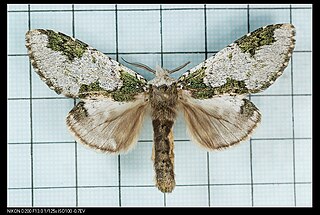
Coprinus is a small genus of mushroom-forming fungi consisting of Coprinus comatus - the shaggy ink cap (British) or shaggy mane (American) - and several of its close relatives. Until 2001, Coprinus was a large genus consisting of all agaric species in which the lamellae autodigested to release their spores. The black ink-like liquid this creates gave these species their common name "ink cap" (British) or "inky cap" (American).

The Psathyrellaceae are a family of dark-spored agarics that generally have rather soft, fragile fruiting bodies, and are characterized by black, dark brown, rarely reddish, or even pastel-colored spore prints. About 50% of species produce fruiting bodies that dissolve into ink-like ooze when the spores are mature via autodigestion. Prior to phylogenetic research based upon DNA comparisons, most of the species that autodigested were classified as Coprinaceae, which contained all of the inky-cap mushrooms. However, the type species of Coprinus, Coprinus comatus, and a few other species, were found to be more closely related to Agaricaceae. The former genus Coprinus was split between two families, and the name "Coprinaceae" became a synonym of Agaricaceae in its 21st-century phylogenetic redefinition. Note that in the 19th and early 20th centuries the family name Agaricaceae had far broader application, while in the late 20th century it had a narrower application. The family name Psathyrellaceae is based on the former Coprinaceae subfamily name Psathyrelloideae. The type genus Psathyrella consists of species that produce fruiting bodies which do not liquify via autodigestion. Psathyrella remained a polyphyletic genus until it was split into several genera including 3 new ones in 2015. Lacrymaria is another genus that does not autodigest its fruiting bodies. It is characterized by rough basidiospores and lamellar edges that exude beads of clear liquid when in prime condition, hence the Latin reference, lacryma (tears).

Coprinus comatus, the shaggy ink cap, lawyer's wig, or shaggy mane, is a common fungus often seen growing on lawns, along gravel roads and waste areas. The young fruit bodies first appear as white cylinders emerging from the ground, then the bell-shaped caps open out. The caps are white, and covered with scales—this is the origin of the common names of the fungus. The gills beneath the cap are white, then pink, then turn black and secrete a black liquid filled with spores. This mushroom is unusual because it will turn black and dissolve itself in a matter of hours after being picked or depositing spores.

Amblyseius is a large genus of predatory mites belonging to the family Phytoseiidae. Many members of this genus feed on other mites such as red spider mites, and also on thrips. Several species are popular as biological control agents to control these pests.

The white-crowned hornbill, also known as the long-crested hornbill or white-crested hornbill, is a species of hornbill.
Amblyseius andersoni is a species of mite in the family Phytoseiidae. It is found in Europe.

Amblyseius tamatavensis is a species of mite in the family Phytoseiidae.

Syntypistis comatus is a species of moth of the family Notodontidae first described by John Henry Leech in 1898. It is found in China, Taiwan, India, Myanmar, Thailand, Vietnam, Malaysia, Indonesia the Philippines and New Guinea.
Dasypsyllus comatus is a species of flea in the family Ceratophyllidae. It was described by Karl Jordan in 1933.
Pseudangulatus comatus is a species of beetle in the family Cerambycidae, and the only species in the genus Pseudangulatus. It was described by Dillon and Dillon in 1959.
Typhistes comatus, is a species of spider of the genus Typhistes. It is endemic to Sri Lanka.
Typhlodromips swirskii, the Swirski mite, is a species of predatory mite in the family Phytoseiidae. It is used in biological pest control of western flower thrips in greenhouse or indoor grown crops.

Dolichopus comatus is a species of long-legged fly in the family Dolichopodidae.
Phobetus comatus, or Robinson's rain scarab, is a species of scarab beetle in the family Scarabaeidae. It is found in North America.
Pityoborus comatus is a species of typical bark beetle in the family Curculionidae. It is found in North America.
Gerris comatus is a species of water strider in the family Gerridae. It is found in North America.
Phidippus comatus is a species of jumping spider in the family Salticidae. It is found in North America.
Pandanus comatus a species of plant in the family Pandanaceae. It is native to Madagascar.







